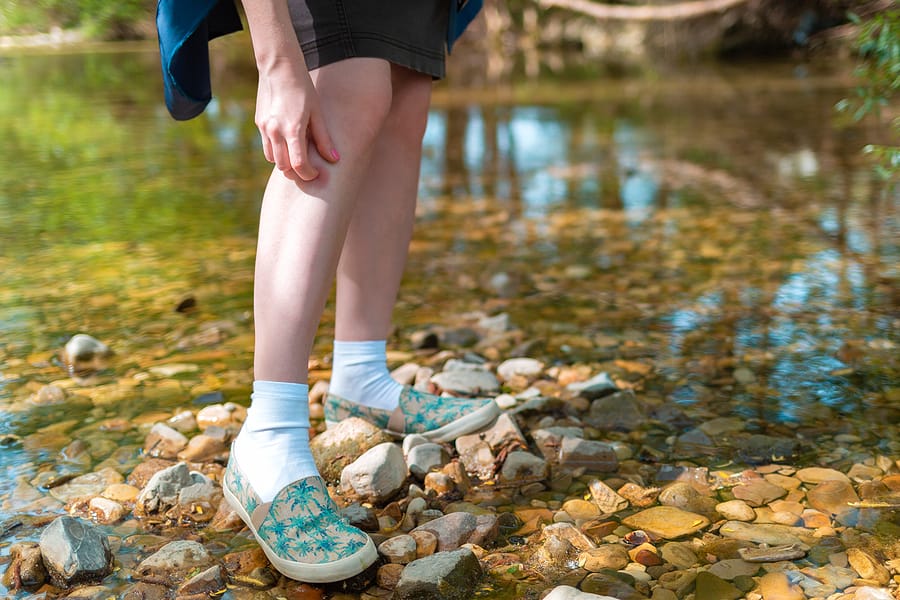READY TO GET STARTED?
REQUEST A FREE ESTIMATE
Fill out the form below or call (888) 466-7849 for a free, no-obligation estimate.

If you live in the south, chances are you’ve been bitten by a bug you can’t even see, leaving you with an itchy, red rash. Chiggers, AKA red bugs, are known scientifically as trombiculid mites. These pests aren’t even technically bugs – they’re actually arachnids and related to spiders and ticks.
Chiggers are found in every country around the world. They prefer environments that are moist and grassy, such as fields, forests, berry patches, and lawns. They are tiny and can usually only be seen with a microscope. Adults are 1/60″ in length and have 8 legs. Larvae are smaller, usually less than 1/50″ and are wingless and red with 6 legs. The larvae will turn yellow after eating. Chiggers are common in late spring, summer, and early fall. They are active when temperatures are between 77 and 86 degrees Fahrenheit and will die off when temperatures drop below 42.
Adult chiggers don’t bite. The larvae will hatch and then clump together on leaves and grass. As you walk through these areas, they attach to you. They then crawl around until they find bare skin and use their claws to make tiny holes in your skin. They inject saliva into the hole that turns your skin cells into mush which they then eat, leaving you with an itchy, red rash. They can bite anywhere on your body but will typically cluster around legs or waists.
Chiggers don’t spread disease to humans but scratching the rash can lead to infection.
Because they’re so hard to see, it can be difficult to even realize you have a problem with them until after you’ve already been bitten. Prevent chigger bites by:
If you have a problem with chiggers or any other pests this summer, contact your local pest control company for an inspection and appropriate treatment plan.
How to Care for Your Crawlspace
Signs of A Centipede Infestation

Chiggers, also known as red bugs, trombiculid mites, harvest mites, harvest bugs, harvest lice, mower’s mites, and berry bugs, are tiny red bugs that leave a big itch in their wake. These pests, classified as arachnids, aren’t dangerous but can be quite a nuisance if you get bitten. So what are those little red bugs and how can you avoid them this summer? Here’s everything you need to know about chiggers and how to prevent them.
Chiggers are tiny, about 0.3 mm in length. They are barely visible to the naked eye and often have to be seen with a magnifying glass. They can be red, orange, yellow, or straw colored. Juveniles (larva) have 6 legs while adults have 8. They are often visible once they congregate in clumps on the skin.
Chiggers can be found in every country worldwide but there are only 2 species in North America that are bothersome to humans with the most common one being Trombicula irritans. Chiggers prefer moist, grassy areas like fields, forest, lawns, and moss. Chiggers are most active when temperatures are between 77 and 86 degrees Fahrenheit and die when the temperature drops below 42 degrees.
Adult chiggers don’t bite; larvae do. Once these babies hatch, they clump together in large groups and attach to animals and people as they walk by. They then crawl on their host until they can find a patch of skin to feed on. They don’t actually burrow into or remain inside the skin as is popularly believed. Instead, they use their jaw-like claws to make a tiny hole they inject saliva into. The saliva liquefies the skin cells, providing a meal for the chigger. The skin around the bite hardens, creating a feeding tube for the chigger called a stylostome. The jaws of chiggers are quite delicate and are best able to penetrate the skin where there are wrinkles or folds. They can latch anywhere onto the body but will most often cluster in areas around the ankles, groin, crotch, knees, armpits, and waist.
Chiggers don’t bite when the temperature is below 60 degrees Fahrenheit or above 99 degrees. Bites can often go undetected for 1 to 3 hours before itching begins. If undisturbed, chiggers will feed for several days. Pronounced itching is the most common symptom of chigger bites. This itching can last for several days. The area around the bite can also become red with a rash, hives, bumps, or blisters. Chiggers aren’t known to spread diseases in North America but scratching the bites can lead to irritation and infection if the skin is broken open. Chigger bites can take 1 to 2 weeks to heal.
While chigger bites aren’t dangerous, they can be a nuisance, especially if the itching is severe. After being outdoors, perform a full body check, using a magnifying glass to see better. Chiggers can be seen as tiny red dots either anchored into the skin or moving quickly across your body. Once you come indoors, take a bath or shower and scrub your skin with soap and water to remove any lingering bugs. Wash any clothes, blankets, or towels that were worn or used outside in hot water to kill any bugs that might still be hanging on. Treat your bites with over-the-counter anti-itch cream or ointment like menthol, calamine lotion, or hydrocortisone). If the itching gets too bad, try over-the-counter antihistamines (like Benadryl) and use cold compresses at the site of the bite.
Chiggers can usually be prevented by following the techniques above. If you suspect you have a problem with chiggers or any other pest, contact a professional pest control company who can provide you with the most current and appropriate treatment and prevention options for you.
Wildlife: Leaving a Mess Behind